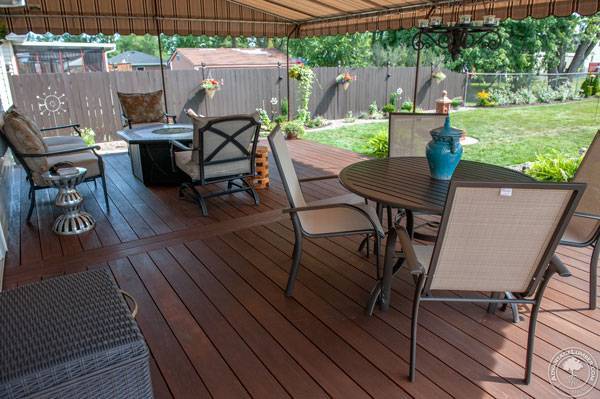To answer the question, we have to understand the other popular products and what they bring to the table. For decades, the most popular materials for building decks were pressure treated wood, redwood, or cedar. Recently, composite decking came into the field with mixed results among home owners.
Pressure Treated Wood
This material is extremely popular because it’s cheap and easy to work with. But low prices always come with a hidden drawback. Pressure treated lumber’s drawback is maintenance. Stripping, sanding, staining—you don’t have time to do that year after year! What’s more, recent studies have shown that pressure treated wood can leak chemicals when wet. Definitely not something you want around your family.
Cedar and Redwood
These two woods are highly regarded because they have strong performance records. Unfortunately, the bug-resistant wood with a 30+ year lifespan has become scarce. If you were to price out full heartwood cedar or redwood today, it would cost significantly more than Ipe or the highest quality composite.
Composites
Composites came into the decking world as a wonder product: all the good qualities of wood, none of the drawbacks. Unfortunately, it was too good to be true. Composite decking suffered from issues ranging from mold to unstable boards. Companies tried to address the most common complaints, but many problems persist to this day. Composite is still a plastic product that doesn’t look or feel like wood. It’s not as strong as wood. It requires special installation techniques to ensure a safe deck.
Ipe
We offer a long-lasting product that requires almost no maintenance, is 100% natural, and is the strongest decking option available. Ipe is a beautiful dark brown hardwood with hints of olive green and red. It has a 75+ year lifespan thanks to its high density and naturally occurring preservative oils. Its maintenance requirements are simple: casual sweeping, rinsing with warm water, and coating with Ipe Oil to preserve the color. If a silver patina is what you’re after, forgo the Ipe Oil and let the wood weather naturally.
If you have any questions, give us a call at 1-877-232-3915, send us an e-mail at [email protected], or drop us a comment below.

Need more info on ipe
Hello Nick,
What info are you looking for? A few questions I can answer through here, but if you require some extensive information, feel free to send us a message at [email protected]
Thank you Nick,
-G.Alves.
I so recommend Ipe, We have a huge deck that is critical to our backyard (it provides a solid surface bridging two tiers of yard) We chose Ipe because finishing cedar & other woods is a pain. I couldn’t be happier – still gorgeous with little effort. I love knowing i’ll never have to replace it. Pain to install but worth it!!
I want to replace my old wood deck that required maintenance painting/staining every year. This deck takes a weather beating….afternoon sun can warm up to 100+F degrees and the Western PA winters can dump 2′ of snow and take the temperature down to -10F. I am researching Trex, Azek, and real wood. I am very interested in the Ipe wood. This is an elevated deck with dry entertaining below. Do you offer any products such as the “rain escape”. In reading your installation it seems that the Ipe wood requires a lot of air circulation. Do you have any installations in the Pittsburgh area?
You are correct that Ipe needs sufficient airflow underneath to allow moisture to be absorbed and released evenly. We don’t have any recommended installers list for any location. However, please be sure to look for installers that have used the wood for several years not just any deck installer. Typically an experienced installer can find solutions for drainage and airflow that’s unique to your needs.
Price per lineal foot 6″ wide X 14 feet for ipe
What are the specific recommendations for sufficient air flow?
It depends what thickness you’re looking for. 1×6, 21×6, or 5/4×6. Here’s our full price chart for your convenience: http://www.advantagelumber.com/decking2.htm
We recommend 18″ of open space from the bottom of the deck to the top.
With a ipe deck surface close to the ground, ie, approx. 15 inches should I put a plastic vapor barrier on the ground. There is a slight slope, but not enough to prevent random puddling. Was considering poking holes in puddle prone locations.